ARP Sign
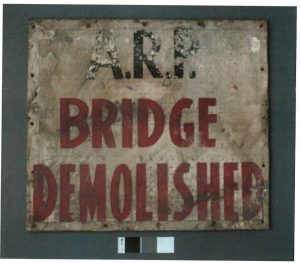
Object
Our latest post looks at the history and treatment of a WW2 ARP sign from Beamish Museum’s collections. The sign reads ‘ARP Bridge Demolished’ in black and red paint on paper, which is adhered to a large piece of multi-ply paperboard. The paperboard has then been attached to a wooden frame.
The ARP abbreviation places this object firmly within the context of the Second World War period (1939-1945). A.R.P stands for Air Raid Protection, which was a voluntary service responsible for protecting civilians against air raids in the UK. Air raid precautions began as a government department set up by the Committee of Imperial Defence in 1924 in response to the great changes in warfare since the First World War. Air raids on Britain during WW1 were limited to strategic zeppelin bombing raids over London and south-east England. The inadequacy of primitive home defences against these attacks, and later the use of poison gas and high explosives against civilians made the threat of deadly aerial bombardment on home soil a real possibility in the event of another war, elevating the so-called ‘passive air defence’ to high priority status within the British Government.
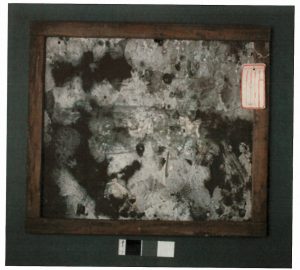
Throughout the 1930’s the British government stepped up its development of the ARP. In 1937 the Air Raid Precautions Act was passed, placing the responsibility of maintaining the ARP services and training on local authorities instead of the Home Office. Together with the Police Reserves and the Auxiliary Fire Services, the ARP was one of three voluntary services available to join.
The main responsibilities held by the ARP were to communicate the government’s official policy of preparing the population for war, and to advocate measures to enhance the personal protection of the public. In practice, this translated into a host of literature giving advice on issues ranging from maintaining a properly functioning gas mask and constructing air raid shelters, to evacuation and blackout procedures.
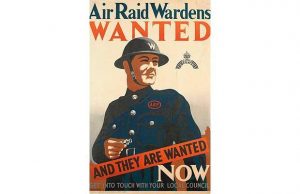
ARP wardens played a vital role in the Home Front. Their presence amid neighbourhoods aimed to bring comfort and calmness to the inhabitants. Warden Posts were set up on street corners, from which air raid wardens reported damage and casualties to the local Civil Defence Control Centre via messages. Regional ARP Control Centres were effectively the nerve-centre of local ARP operations.
This sign is clearly warning the reader that a particular bridge has been demolished and reference to the ARP would suggest the organisation’s official involvement. Though the specific bridge that had been demolished is unknown, its significance as a bombing target is clear. Bridges are an important part of a country’s infrastructure, often providing the sole means of traversing hilly terrain or waterways. In times of war, maintaining these routes is vital to keeping up the war effort, particularly in regions dominated by heavy industry like the north-east of England. The scale of this type of disruption and devastation would have been potentially fairly high.
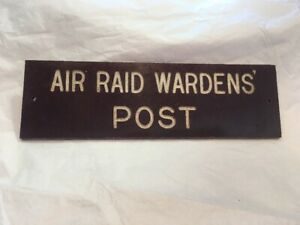
It appeared evident from visual examination that the ‘ARP Bridge Demolished’ sign had been painted over another sign. Infrared photography was carried out in order to investigate the nature of this underlying sign and to see whether the extent of the design could be determined. Infrared photography uncovered a grid-like design that also appeared to relate to ARP activities during the war. It consisted of a colour-coded table with a list of hazards against which pins would have been inserted, possibly to mark which incidents had occurred.
Condition
- Evidence of dust and dirt on the surface
- Signs of water staining on the surface
- Evidence of flaking black paint
- Signs of iron corrosion on the nails and iron staining around them
- Warping of the paperboard
- Some tears/losses to the paper
- Evidence of abrasion to the paper surface
- Signs of mould growth on the reverse.
Conservation
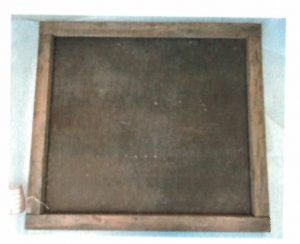
As there was evidence of mould growth on the reverse of the obejct this required removal before further treatment could take place. Initially the mould was removed using a soft bristle brush and a vacuum on low suction; as this only removed some of the mould the reverse of the sign was further treated using an appropriate solvent solution in order to kill the mould spores and prevent regrowth.

Following this the sign was surface cleaned in order to remove dust and dirt that was obscuring the paint and design underneath. During tested one of the methods began to remove the whitewash layer, which had been put over the top of the original design so the ‘ARP Bridge Demolished’ sign could be painted. This created an interesting situation and options needed to be considered regarding the extent of cleaning and whether this whitewash layer should continue to be removed in order to reveal more of the original design underneath. Following discussions with the collections team at Beamish Museum, the decision was made to remove the whitewash layer in order to reveal the lower layer of decoration, however the ‘ARP Bridge Demolished’ lettering would remain intact. The red paint was then further cleaned using an appropriate solvent in order to remove further dirt and brighten the lettering.

Once surface cleaning had been completed and the whitewash layer had been removed, it was determined that the black paint required consolidation in order to prevent flaking and further loss of the orignal and later design. Testing was performed to see which consolidant was the most effective and this was then applied to the surface where there was evidence of paint.

The iron nails, which were holding the paper and paperboard to the wooden frame were severely corroded but as they were all that was holding the sign together they required treating in order to ensure the stability of the object. They were treated with a rust converter, which would convert the corrosion to a more stable form, and would help to protect the nails from further deterioration.
